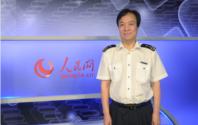 Online Interview
Online Interview
Topic: Beijing-Tianjin-Hebei Customs Clearance Integration Measures
Time:09:00 AM (Fri) June 27, 2014
Special Guests:XIE Jinyong, Deputy Director General and Party Leadership Group Member of Beijing Customs District, and ZHAO Weizhen, Director of Customs Supervision and Clearance Department of Beijing Customs District
Beijing-Tianjin-Hebei Customs Clearance Integration Measures
[Host]: You said the logistics at several ports are seamlessly connected like a hub. If something goes wrong in Beijing, how should a firm in Tianjin respond, just by a phone call? [09:24]
[Xie Jinyong]: Now we call it the first-consulting responsibility system. The problem of an enterprise, in principle, should be solved at only one place. For instance, if Tianjin Customs has found a problem, then it will immediately inform Beijing Customs. Anyway, the objective is to solve the problem nearby, reducing the business trips of enterprises. Thus the enterprises will enjoy more convenience at the nearest customs with high efficiency and less cost. The three Customs Districts have reached the consensus. [09:25]
[Host]: From your introduction, I know there is a customs supervisory certificate commonly used in the three regions. The certificate contains electronic license data, are the electronic data generally acceptable in Beijing-Tianjin-Hebei regions? [09:25]
[Xie Jinyong]: The supervisory certificate is based on computer network. During the application for the certificate, enterprises should tell the license-issuing authority the port where they will pick up goods and then the certificate will be automatically sent there. [09:26]
[Host]: Is this declaration formality complicated? [09:26]
[Zhao Weizhen]: The State Council has been stressing administrative streamlining and power delegation to the lower levels. The formality is becoming increasingly simpler. Now the supervisory certificates are mainly issued by the Ministry of Commerce, local commerce administrations, AQSIQ, SFDA (State Food and Drug Administration), etc. The Customs are just implementing the supervision. Now the declaration formality is going simpler and simpler. [09:26]
[Host]: Director Zhao, for the electronic data, will we go for inspection each time or use those electronic data for a period of time? [09:26]
[Zhao Weizhen]: Well, it depends. For the large and medium-sized bulk cargo, such as grain, crude oil, minerals, the licenses can be used for multiple times. For others like electronic equipment, machinery, especially the products under strict control, their licenses are used only once, which we call “one license for one consignment”. [09:27]
[Host]: Well, Director Xie, such clearance integration will gradually extend to the Yangtze River region, Guangdong Province and other regions. Are there any differences from the previous contact work? [09:27]
[Xie Jinyong]: The management is based on customs district. In the Yangtze River region, there will be several customs districts to integrate like Beijing-Tianjin-Hebei regions. In Guangdong Province, there will be several customs under integration, giving play to the comprehensive effect of the integration. [09:27]







